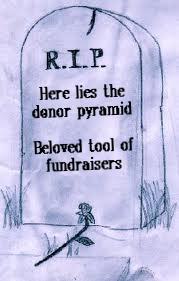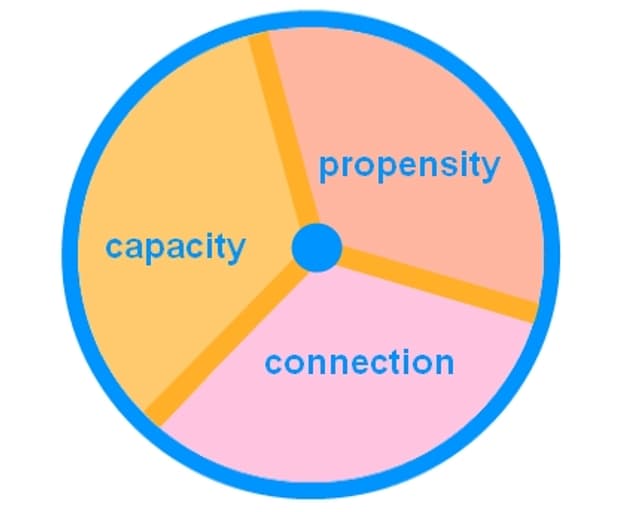The donor pyramid is dead… Long live the donor pyramid!
Sarah Clifton shares her thoughts and asks: What exactly is the purpose of the donor pyramid if not to map the upgrade journey to a major gift?
- Written by
- SOFII
- Added
- May 12, 2011


A number of fundraising headlines have proclaimed the donor pyramid to be dead. And working in America, I hadn’t heard too much about it since my early days in fundraising (way back in the ’90s!) except an occasional chuckle and a “that old thing!” retort at its mention. It used to be that in America, where major gifts represent a large share of fundraising income, the pyramid could illustrate which 20% of donors contribute 80% of giving income.
But even before my time as a fundraising professional, the pyramid had already come to be seen as a very simplistic measure of success. So naturally, I too thought it was dead. Until I moved to the Netherlands where it’s alive and kicking (and screaming). In fact the donor pyramid is not just alive here in the Netherlands – it is beloved.
Why exactly? Is it that the pyramid is actually so useful or is it that there are no good alternatives?
But first as many wiser fundraisers than me have tackled the question of the pyramid, it’s only fair that I acknowledge their contributions before throwing mine into the mix.
Among them, Mark Rovner has argued that the donor pyramid is a lie because it assumes that donors come into an organization at the bottom with small gifts and, as loyalty builds, rise up over time to make major gifts. This leads us as fundraisers to think in terms of formulas to move as many core donors up the pyramid, when, in fact, major donors come to the organisation generally through other major donors and not through the ranks of the direct marketing (DM) programme.
Rovner writes that:
“Many low-dollar fundraisers assume that our entire relationship with a donor can be programmed like a computer. I don’t need to talk to people, I just keep tweaking my algorithms and direct the right solicitations to the right people at the right time and the money will just roll right on in.”
He illustrates that major gifts fundraising is a different model altogether and has little to do with traditionally pyramid-governed DM programme.

I agree with him on this latter point, as do, I think, most major gifts fundraisers. The last decade has seen the introduction of a model of using “propensity,” “capacity,” and “connection” to identify potential major givers instead of just gift history. These factors help predict the willingness and ability of a donor to make a large gift better than just looking at DM behaviour.
What I don’t agree with him about, at least not totally, is that major donors don’t come at the bottom. I have seen donors identified from the DM programme and then moved into a major gifts cultivation strategy, effectively. And my own experience tells me that more major donors than not begin their financial relationship with an organisation through the DM programme before they go on to make a substantial gift. This is also confirmed by research from Target Analytics.
But whatever “predictors” you use to find a potential major donor, they ultimately only indicate that a donor should be cultivated personally. Not that they will actually become major givers.
This brings me to the central question of this post: What exactly is the purpose of the donor pyramid if not to map the upgrade journey to a major gift? What does it show? What does it not show?
In the Netherlands, where major gifts fundraising is still quite young, the pyramid seems to have a bit of a confused role. Here is seems often to be used as a planning tool – somewhat removed from the whole major gifts question.
But is this actually as confused as it seems? Does the donor pyramid have value to offer in a market where fundraising is often focused more on the loyalty of lower value givers and less on the upgrade to a major gift? What exactly, if any, is the role of the pyramid in fundraising management?

First, it is an excellent tool to use in explaining fundraising in simple terms to board members. (John Sauve-Rodd has also made this point in a discussion over the pyramid in The Agitator — see Dead Wrong, And Dead Right, The Donor Pyramid Lie– II, – III, -IV, and -V).
Further, the pyramid can serve as an excellent management report to visually represent the monetary value of your donors within a given time period (a calendar year, for example). It can give you a snapshot of how many donors are giving at the value levels that are important to your organisation.
But the simplicity of this model is often mistaken by fundraisers to be a basis for managing or segmenting donors. That is, in my view, a misuse of the pyramid. The reason why lies in what the pyramid is not:
1. It is not segmentation
Unless you manage a very small programme, where all donors within a single cumulative giving bracket are treated the same, the pyramid will not take you very far. Other factors – including engagement (how and how often the donor interacts with your organisation), gift type or product, financial capacity, demographic factors (such as age) and interests – are not taken into account. These are often far more important in segmentation within a given communication or even a whole programme.
2. It only shows current giving, not the upgrade journey
How do you know, by looking at the pyramid, which donors should be targeted with which products? You don’t. The pyramid is a look back in time, not forward. In a good fundraising programme, you are also planning an upgrade strategy for each type of donor. For example, some donors should be targeted for a major gift (again, based on “propensity,” “capacity” and “connection” – factors which are not reflected in the pyramid). Some should be targeted for monthly giving and some for a legacy. These are all based on factors which have very little to do with merely how much a donor gives in a year.
3. It does not (at least should not!) reflect the structure of your fundraising program
An individual giving programme needs to be structured around the lifecycle of the donor – acquisition to raise new donors, reactivation to re-engage previous donors who have stopped giving, retention and upgrading to keep your active donors loyal and build their value, etc. And of course major gifts and legacy fundraising which are based on totally different criteria and strategies all together.
In a typical pyramid, a new donor who gave a gift of €60 last year (with at best a 40% chance of ever giving again) will be in the same layer as a loyal donor who has been giving €60 per year for the last twenty years. Do these really have the same value? Are they really managed the same? Not at all. One is being cultivated in a conversion programme (to convert them to a loyal donor) whereas the other may be targeted for a legacy.
So, is there an alternative? Back to those wiser…
Tony Elischer from THINK Consulting Solutions in the UK has proposed several, including a modification to the traditional pyramid. You can download his thought-piece, Rediscovering & Climbing The Donor Pyramid, here. Several fundraising thinkers have also proposed a donor trapezoid. You can read the various views on this in The Agitator series.
But I am really interested to hear from readers what you recommend. What model do you use as the basis for planning and reporting your donor stratification? How do you represent the different donor value groups to your senior management and board?
And Dutch fundraisers: Why is it that the pyramid is so popular here? Are there also popular alternatives? Are there those of you out there that use it effectively? How so?
Please post your thoughts here in the comments. I look forward to a lively discussion!
© 101fundraising 2011



















